If you’re looking for how to get to the back entrance of Petra then you’ve come to the right place! This post is a super-detail discussion on how to enter the incredible archaeological site of Petra from the back entrance and it will provide you with all the information you could ever want to know.
Petra is quickly becoming one of the most popular tourist destinations in the world. And for good reason, it’s simply stunning! But you’re like me and you want to see amazing places without the crowds.
So you’re going to enter Petra from the back entrance and get to one of the most Instagrammable places on the planet before other people! Read on to learn all about getting to the back entrance of Petra.
Note: this article contains affiliate links, which means that should you purchase something or get a quote through them I may make a small commission at no additional cost to you. This helps keep the site running with up to date information. I do not represent World Nomads, Booking.com, GetYourGuide, or Rentalcars.com. This is information only and not a recommendation to buy the product mentioned in this article.
Petra – What You Need to Know
What is Petra?
Petra is a sprawling ancient city carved into the sandstone mountains of southern Jordan. It’s not known exactly when it was first founded, but evidence of its settlements trace back to at least the second century BC. The city was the capital of the ancient Nabataean people, nomadic Arab traders.
At its peak in the first century AD the city was home to some 20,000 inhabitants. Petra is most well known for the way the Nabataeans carved impressive facades into the mountains and created massive cave buildings behind the facades.
Where is Petra?
Petra is in southwest Jordan, deep in a small range of colorful sandstone mountains. The nearest town is Wadi Musa, a small city that exists almost exclusively to handle Petra tourism. Wadi Musa is about a three hour drive south of Amman, the capital of Jordan.
How to get to Petra
You’ll most likely be flying into Amman (or possibly Aqaba, as it has some flights to Northern European destinations). From there it’s about a three hour drive to Wadi Musa if you’ve rented a car (see next section about driving in Jordan).
There are multiple parking lots for Petra (some free, some paid), but your hotel will likely have parking as well. You can find a great deal on a rental car from the Amman Airport using the search bar below.
If you’re not driving yourself then there are three ways to get there. The most common way people get to Petra is through an organized tour. There are literally dozens of these that do day trips from Amman or overnighters in Wadi Musa. They start at around $100 but don’t include admission to Petra.
You can check out Petra tour options on GetYourGuide here.
If an organized tour isn’t your thing there you can take the bus or a private transfer. Private transfers are basically nice taxis and the rates start at about $200 round trip. If you’re not looking to spend that much, take the bus.
There is a direct bus – the JETT– which leaves Amman at 6:30 AM every morning and returns around 10 PM. This must be booked in advance. There are also local minibusses – the most affordable way to get to Petra. These leave throughout the day and no prior arrangements are necessary.
Driving in Jordan
Driving in Jordan is safe, affordable and effective. Road signs are in Arabic and English and road rules are similar to any western country. The roads are also mostly in good condition and drivers are not reckless (like in Georgia). I highly recommend renting a car to get around Jordan.
That being said, there are a few things to lookout for when driving in Jordan:
- The rental company will inspect every little teeny tiny nick on the car and their standard insurance does not cover these tiny marks and scratches.
- Speed cameras are literally everywhere, you will likely get a speeding ticket unless you are meticulous about driving under the limit.
- Stray dogs and cats are also everywhere so you have to be constantly on the lookout.
- When driving in small towns be careful because children literally walk in the middle of the road. They also think it’s funny to open car doors and throw small rocks at your car so be on the lookout for that too.
- Gas is pretty cheap, not much more than it is in the United States, and they pump the gas for you.
Language
The language in Jordan is Arabic. As Jordan has become a hit tourist destination since 2010, English is becoming more common amongst the locals. People working at hotels and restaurants that depend on foreign tourists will speak decent enough English. Outside of the tourists hotspots though, don’t expect people to speak anything other than Arabic though.
Money
The Jordanian Dinar (JOD) is the currency. Like a few other currencies, especially in the Middle East, it’s pegged to the US Dollar. That means that the currency is set to a fixed value to the dollar. 1 JOD is equal to 1.41 USD and it never changes. If you’re from the eurozone or Australia or elsewhere the stronger the US Dollar gets the more expensive your trip becomes.
You will need cash in Jordan. While most restaurants and all hotels will take cards – even many souvenir stands in Petra – Jordan is still a cash society. You’ll want to carry enough cash to be able to get through a day without a credit card. Tipping is also common in Jordan for tour guides and other services.
Jordan is sort of a tale of two cities when it comes to how expensive it can be. If you’re in a place that tourists don’t frequent, it can be incredibly cheap. But somewhere like Petra can be quite expensive. Restaurant prices are cheaper than in the US but more than you’d expect for a country with significantly lower GDP.
PRO TIP: Some places in Jordan will try to charge you in your home currency when paying by credit card. When this is done the Jordanian government automatically adds a ridiculous 10% surcharge to the amount. Always – I repeat ALWAYS – pay in Jordanian Dinar.
Another thing to note is that literally every price in Jordan is negotiable. Many locals will try to rip you off so be sure to ask prices beforehand if no prices are displayed. And even then all prices can be haggled down. If you feel the price of something is too high you can suggest a fair price and they’ll often agree.
Weather
The weather in Petra varies depending on the season. It’s a desert, so the temperature can change drastically from day to night. Summers are not as hot as other destinations in Jordan thanks to the high elevation, but summer days do often get above 100 F (38 C) and winter nights can be bone chilling cold. Skies are usually clear and sunny, but it does rain more than you’d think for a desert.
When to visit Petra
Given the hot summers and how much hiking is involved in a visit to Petra, it’s best to avoid July and August if you can. April to early June and mid September to early November are the ideal times to visit. If your number one priority is avoiding people, winter is your best bet. Even then, the more popular sights in Petra will still be crowded.
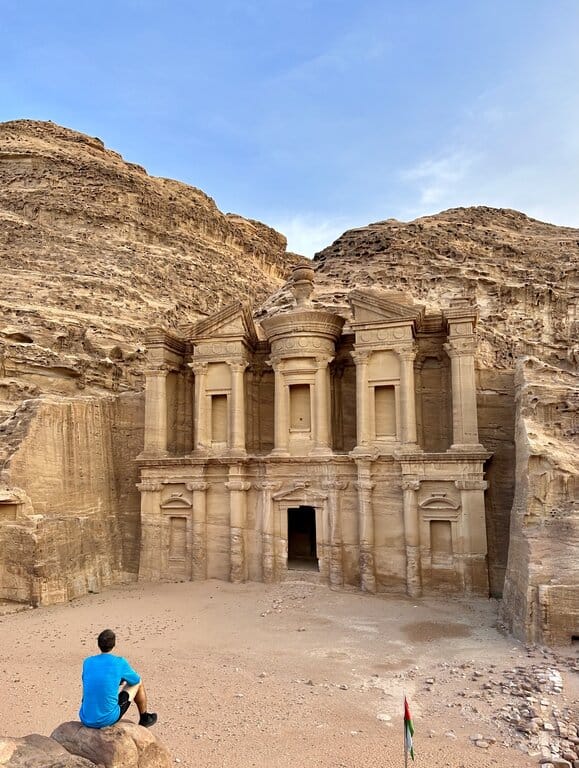
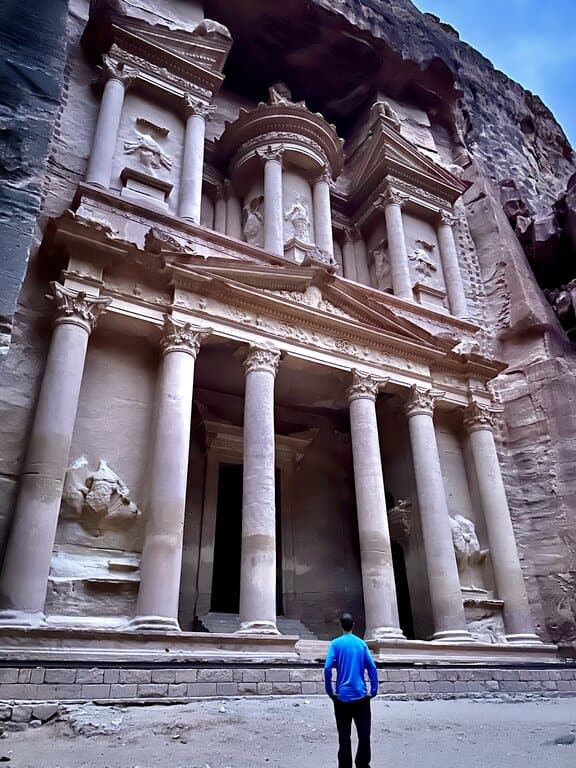
Jordan Pass
The entrance fee for Petra is steep, like $70 USD steep. And that’s just for a one day entry. A three day entry will run you $85. But never fear because Jordan Pass is here.
Jordan Pass is like a museum pass for all the archaeological and historical places and museums in Jordan. On top of that, it includes your Jordan entry visa, which alone is $60. Jordan pass comes with three options – aligned to the three options for Petra – a one day, two day, or three day Petra entry. All other sites are one day entry. The Jordan Pass is 70 JOD ($99), 75 JOD ($106), or 80 JOD ($113), respectively.
Even if you do nothing but visit Petra on your trip to Jordan it saves you money to buy the Jordan Pass. You must purchase it ahead of time and carry a printout or a PDF on your phone to gain entry to the sites. It also covers many other places like the Amman Citadel, the Roman ruins of Jerash, Wadi Rum, Shobak Castle and more.
Note that it expires after two weeks from when you enter Jordan at immigration, so if you’re spending more than two weeks in Jordan plan accordingly.
Where to stay
There are many small local hotels in Wadi Musa and a few large name brands like Mövenpick and Marriott. The Movenpick Resort Petra is literally at the entrance of Petra. The Petra Marriott Hotel is located high on the mountain overlooking Wadi Musa and Petra, about 10 minutes from the entrance. But if you’re willing to pay for the Marriott you probably won’t mind paying a few extra JOD for the taxi.
Most of the local hotels are small, with a limited number of rooms. But many offer great services and extensive breakfasts. We recommend staying in one of the local hotels such as Esperenza Petra, where they have top notch service in a comfortable room with great food.
If you’re looking for something a low end of the budget spectrum there are plenty of options for under $50 USD per night with a lot of good hotels under $30 as well. For a nice budget place just a stone’s throw from the entrance of Petra, consider the Petra Moon Hotel.
If these options don’t float your boat you can check out the full listing of hotels in Wadi Musa on booking.com and find something more suitable for you.
How long to stay
How long to spend in Wadi Musa depends on how you’re visiting Petra. If you’re doing a day trip, then obviously you’re not spending the night. My recommendation is to spend two nights in Wadi Musa with a 3-day pass for Petra. This allows you time for an afternoon, a full day, and the following morning. This can be extremely beneficial if the weather isn’t great or there is a cruise ship that comes in. That’s right, folks. Cruises stop at Aqaba and the cruisers get driven to Petra for the day.
If you stay two nights you’ll also likely get a chance to visit Petra at night. See the full section at the end of this post on Petra at Night. At a bare minimum you want a full day in Petra. Whether that means one or two nights in Wadi Musa is up to you. You really need at least a full day to appreciate Petra.
Petra is best enjoyed as part of a longer road trip around Jordan that also at least hits the Dead Sea, Wadi Rum, and Amman.
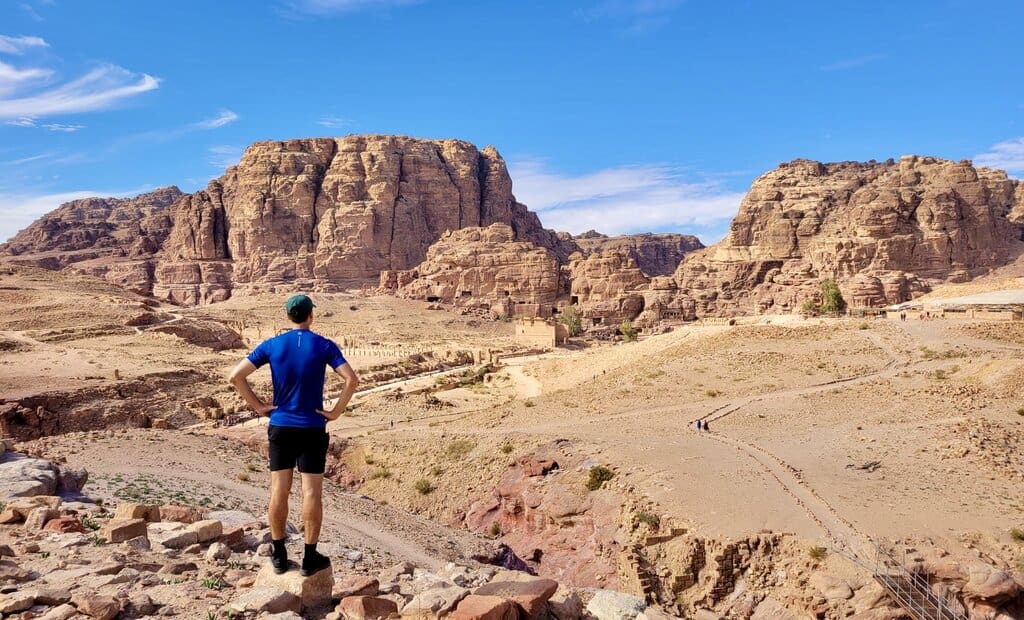
Food
You’ve probably never been to a Jordanian restaurant. It’s not a super well known cuisine. We won’t go into a full breakdown of Jordanian food, but it’s similar to other middle eastern food with a few local staples.
Some unique things to be sure to try are maqluba – a hearty chicken, potato and rice dish – and mansaf – Jordan’s national dish of rice, lamb and yogurt. For dessert, get your hands on some kanafeh, a super sweet cheesy, syrupy pastry. Simply devine.
In Wadi Musa most of the hotels will offer a buffet breakfast and dinner. Breakfast will be included in your room rate, and dinner is usually about 10 JOD per person. After a busy day in Petra it’s nice to eat your face off at a buffet.
In general, the food in Jordan outside of Amman was not super memorable and overall quite disappointing. It’s probably because the areas cater to tourists so much that food quality has taken a hit. So don’t expect to find anything amazing in Wadi Musa. Save yourself for Amman, which can be a real culinary treat.
Alcohol in Jordan
While Jordan may be one of the most liberal Islamic nations, it’s still pretty conservative by western standards. Outside of Amman and Aqaba, the two main cities that attract tourists, alcohol is only available at large, western owned hotel bars and a few other random bars (and at liquor stores in other large cities). There is nowhere in the town of Wadi Musa to buy a bottle of wine or a 6 pack.
If you fancy a beer after a long day of hiking, there are a few bars that will sell you alcohol, such as the bar at the Mövenpick Hotel and the Cave Bar at Petra Guest House Hotel.
At bars in Jordan expect to pay quite a bit for a drink. The cheapest beer I saw was in Amman and it was 5 JOD plus tax, so about $8 USD. It was more than the meals on the menu. At the nicer hotels and resorts expect to pay a minimum of $12 for a drink.
If that doesn’t sound appealing then you can pick up something at a bottle shop in Amman before heading down to Petra. There are numerous around the city and the prices aren’t too bad. Jordan River Vineyards actually makes really good wine!
If you want to read more about alcohol in Jordan you can check out my entire article on the subject here.
Travel Insurance
When visiting Jordan you’ll want a quality travel insurance policy. We use World Nomads when we travel. Word Nomads provides coverage to travelers in over 100 countries. You can find a great policy on World Nomads by using the link below.
Hiking
To put it bluntly you will cover a lot of ground in Petra. If hiking is not your thing then Petra might not be for you. You can take a horse or a golf cart to see the famous Treasury building near the entrance of Petra. But you didn’t come all this way just for that, did you?
We covered 17 miles (27km) on our day in Petra. That included leaving the park twice to go back to town, but you get the point. Doing the hike from the back entrance actually saves you a few miles, so you’ll cover less ground than if you started at the main entrance.

A Quick History of Petra
Don’t need to read about the history and Petra and all about the site? Just want to know how to get to the back entrance?
Petra is an ancient archaeological park in Jordan that is known today as one of the Seven Wonders of the World. Evidence of settlements in Petra trace back to at least the second century BC, though it’s believed the area was inhabited far earlier.
It’s essentially just a city, where people lived and worked, hunted and farmed. At one point around the first century AD as many as 20,000 people lived in Petra. Petra is most famous for the way the residents carved magnificent buildings into the side of sandstone mountains.
The Nabataens
Petra was the capital city for the ancient Nabataean people. The Nabateans were nomadic Arab traders that lived in the vast deserts of modern day Jordan, Syria, Saudi Arabia, and Egypt.
They were masters at living off the arid, barren land and were particularly known for their ability to harvest and store precious rainwater. They flourished from about the 6th century BC to the first century AD. Right around then, another ancient kingdom you might be familiar with came into the picture.
Roman rule
The Nabataean Kingdom was an ally of the Romans for centuries before it was annexed into the massive Roman Kingdom in 106 AD. Things changed in Petra during Roman rule, as there was less focus on the building of tombs and more focus on things typical of Roman cities.
There’s a large amphitheater in Petra – nothing says Romans more than stadiums and theaters – and the cobblestone main street is reminiscent of the streets of Pompeii.
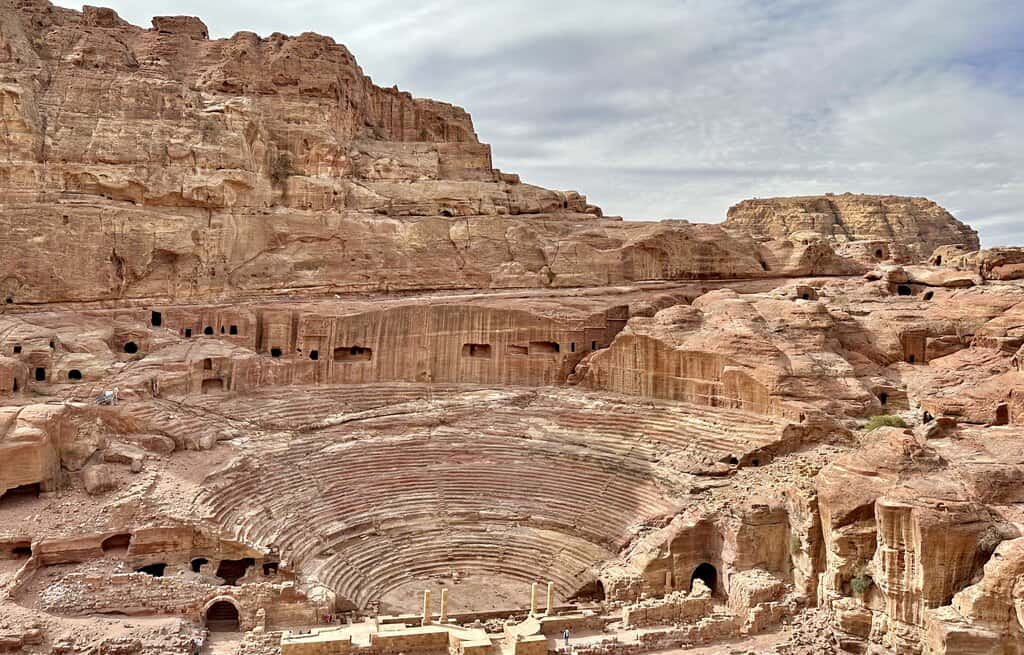
Petra’s decline
By the third century AD the population of Petra was starting to decline. Trade routes were changing and less and less people were passing through the great city. In the year 363 the Galilee earthquake struck the Levant and Petra was mostly destroyed, its detached buildings all but gone and its magnificent facades carved into the rocks taking a serious hit. Residents abandoned the city in droves and it never returned to its former glory.
The Bedouins
Over the next 1500 years various nomadic people settled in Petra. Some Christian churches were built, but by the time Islam swept the region only a few Bedouin tribes here and there remained.
The Bedouins are nomadic Arabs who made their homes in the desert regions of North Africa, the Arabian Peninsula and the Levant. In the Petra region, the Bedouins lived in caves, either naturally occurring or carved into the rocks.
While their nomadic lifestyle faded as the industrial revolution swept the world, many continue to live traditional lives even to today. It was only in the 1990s that the Jordanian government forced the Bedouins living in Petra to move into the town (in the name of tourism). They were given apartments but many missed their cave dwelling days and refused to assimilate to the modern world.
In Petra you will see hundreds of friendly Bedouins, mostly running shops or trying to tempt you into a camel ride. It’s how they make money in the modern world. But they keep their traditions alive, such as drinking a few liters of tea per day!
Rediscovery
The Bedouins remained in and around Petra, living in caves as the centuries went on. The area was completely unknown to Europeans, however, until 1812 when it was “discovered” by a Swiss explorer.
Excavations occurred off and on from then on and are still ongoing to this day. Only in recent years has Petra become a major tourist destination for international visitors. It was named one of the New Wonders of the World in 2007 and has exploded since then.
The Layout of Petra
Petra is larger than most people think. From the park entrance to the Monastery, which sits at the very end, the trail spans about 3.5 miles direct. And that doesn’t include all the side trails, which lead to various viewpoints and additional ruins.
Here we will run through the key sights in Petra and the things you absolutely must see and do. We will order it from the main entrance to the back entrance, so keep in mind if you’re doing the back entrance like I suggest, you’ll come across the sites in reverse order.
The Main Entrance
The main entrance to Petra sits right at the edge of Wadi Musa. There is a visitors center and a ticket counter as well as a museum and services such as bathrooms, restaurants and shops. Whatever you do, avoid these restaurants like the plague. The food is awful and overpriced.
The park opens at 6 AM daily (6:30 from Nov-Mar) and closes at 6 PM (4:30 Nov-Mar). You must purchase your ticket (or show your Jordan Pass to get a ticket) at the main ticket window outside the visitors center. From there you walk through a few shops to get to the gate where your ticket will be scanned and you’ll enter the park.
Once inside, you follow a wide dirt road down a slight incline towards the mountains. You’ll be offered multiple horse rides, and they’ll tell you that it’s included in your ticket. While that is technically true, the horse owners will demand exorbitant tips.
It’s not a bad walk so avoid the horses. You can also pay 15 JOD for a golf cart ride. But come on, you didn’t come here to ride in an oversized golf cart. On either side of the dirt road you’ll see a few carved structures in the rocks. Your first taste of Petra!
The Siq
The entrance to the ancient city is through a giant slot canyon known as the Siq. After about 10 minutes on the dirt road you come to a souvenir shop and a giant crack in the mountain. The path through the slot canyon is quite wide when compared to some other famous slot canyons, but it is still narrow.
With all the people coming and going from Petra it can get crowded in the canyon. It’s a beautiful natural feature of the park though, and it’s thoroughly enjoyable to walk through. It is also paved, in case you want to run when the gate opens at 6 AM.
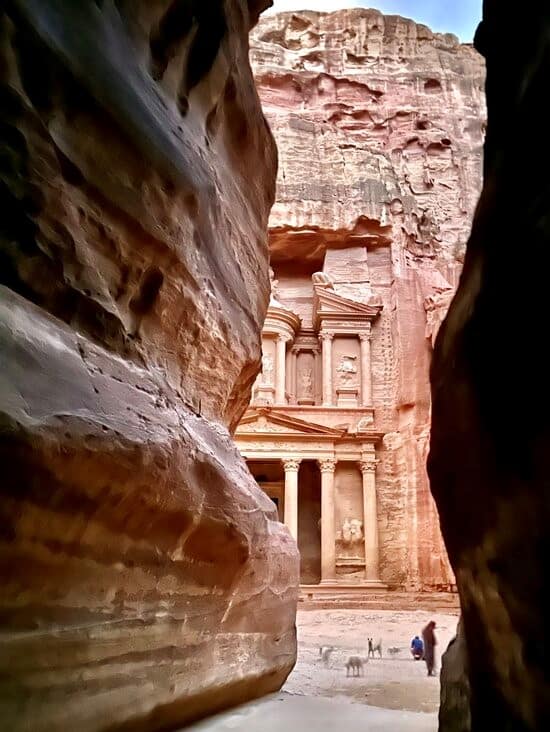
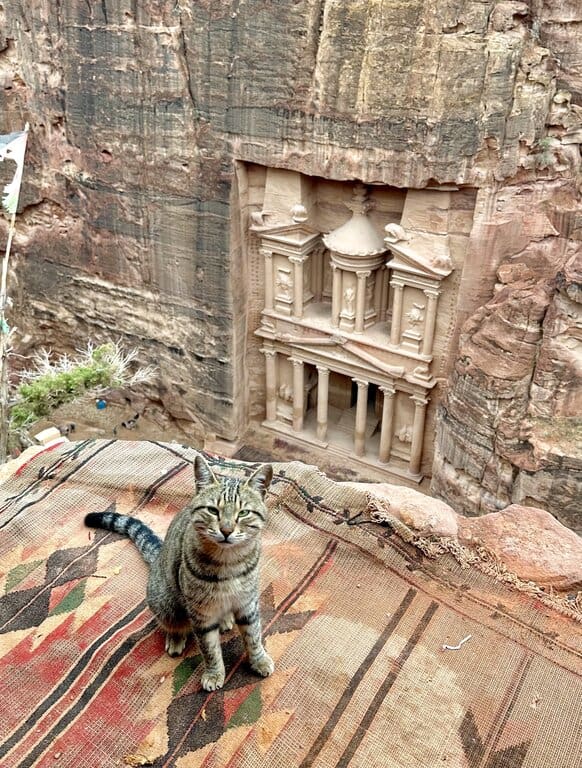
The Treasury
The most famous site in Petra is without a doubt the Treasury. It’s the most visited site in the park and what most people picture when they think “Petra.” The Treasury is an exquisite building carved into the face of a giant red cliff. Its name traces back to the 19 century, as it was historically – as most of the rock carved buildings in Petra – just a giant tomb.
It got its name from legends of treasures being hidden somewhere in the building. There are even bullet holes in the facade from Bedouins in the 1800s who tried to shoot through it to find said treasure. As you can imagine, no treasure was ever found. It really does look like the US Treasury building in Washington DC though!
For everyone who enters Petra from the main entrance – so just about everyone except you – the Treasury is the first landmark they see. It’s the introduction to Petra and for many people it’s all they really need to see. It’s an extraordinary building that’s well deserving of the hype it gets.
Crowds
The main issue with the Treasury is that it is ridiculously crowded. All those photos you’ve seen of someone all alone in front of the Treasury? That’s either photoshop or taken just after the park opens. In our case, as you can maybe tell in the photo below, it was just after the park opened and the sun hadn’t even risen yet.
If you want to be alone in front of the Treasury, this is your only option. It’s less crowded at the end of the day just before the park closes, but there will still be too many people.
At all other times of the day there are literally hundreds of people in front of the Treasury. On top of that, there are probably a hundred Bedouins who work there and a herd of camels. You’ll get many offers for photos sitting on a camel. The price is negotiable so be sure to haggle should you wish to do this.
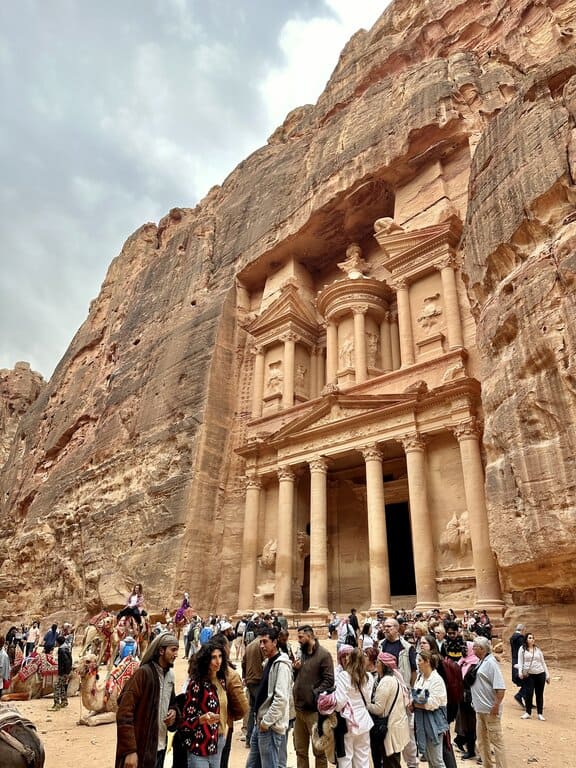
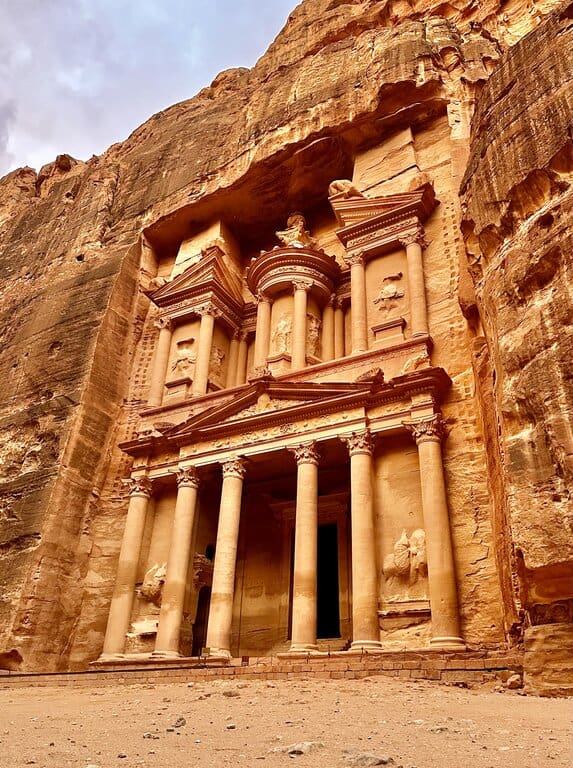
The more common offer you will get in front of the Treasury is a guided hike to the “best viewpoint of Petra.” I’ll go into all the Treasury viewpoints in the next section, but what you need to know about these offers is that they are to take you to a spot about 50 meters above with a direct view of the Treasury.
The walk is steep but only takes about five minutes. You’ll have to pay a minimum of 5 JOD per person for this hike, and the Bedouins will not let you access the trail without paying them.
Treasury viewpoints
The viewpoint described in the last paragraph is certainly stunning, but it’s not the most famous view in Petra. Another couple hundreds meters directly above that viewpoint is the actual most famous view, as seen in the photo below. This viewpoint is a pretty serious hike to get to though, so be prepared. It’s not a simple five minute walk.
From the Treasury you’ll head east through the valley towards the Royal Tombs. Just after the Royal Tombs there is a path that goes straight up the mountain. You’ll climb a number of steps – some ancient and some modern – until you’ve eventually reach the top of the mountains. From there you’ll stroll along the top for about a half mile until you reach the most beautifully located tea house in all of Petra.


The famous view is from the tea house. You’ll have to purchase something from the Bedouin who runs the tea house. He also has fresh fruit juice on top of tea, as well as a hilarious family of cats. The view looks straight down on the Treasury and it is simply stunning.
No more words need to be said, just see the photos above. We had a rainy day and it was still fabulous. If you don’t want to do the hike then the viewpoint discussed in the previous section is for you. You need to do at least one of these viewpoints. Personally, I love to hike so I enjoyed the high point.
The Roman Amphitheatre
As I’m sure you know the Romans loved a good theater performance. They also loved to watch humans fight to the death. So it’s no surprise that when they took control of Petra a large amphitheater was carved into the mountain. It seated about 8500 people and hosted both performances and gladiator fights.
The amphitheater faces the Royal Tombs and is just outside the center of the ancient city. It was greatly damaged by the earthquake in the 4th century. These days, unlike most other ancient amphitheaters, you can’t walk around the seats as that part is closed off. You can appreciate it from the outside though.
The Royal Tombs
Perhaps the most underrated site in Petra is the Royal Tombs. As we’ve already discussed, pretty much all the spectacular buildings in Petra are actually tombs. These ones are called tombs though, unlike the others. There are four large buildings right next to each other, all carved into the rock. They’ve decayed a bit more than the Treasury, but they’re still a sight to behold.
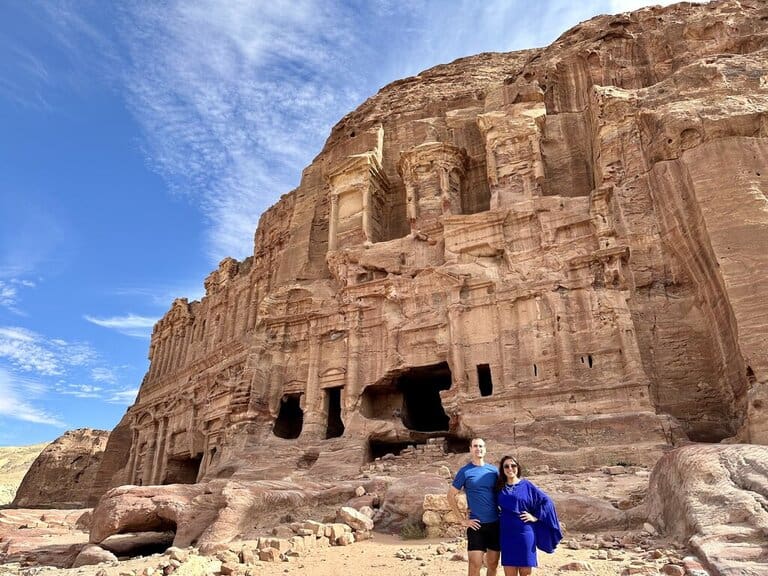
The Great Temple
Unlike most of the famous buildings in Petra, the Great Temple was a free-standing building. It was not carved into the side of any mountain and its architecture is Hellenistic in nature (think ancient Greeks). The temple (whether or not it was actually used as a temple or something else is a subject of great debate) covers over 7500 square meters and must have been a sight to behold back in the day.
These days the Great Temple is mostly just ruins. And to that, most of it was actually buried until fairly recently. In fact, excavations are still ongoing to this day, carried out by Brown University. The Great Temple deserves at least 30 minutes of your time as you wander through Petra.
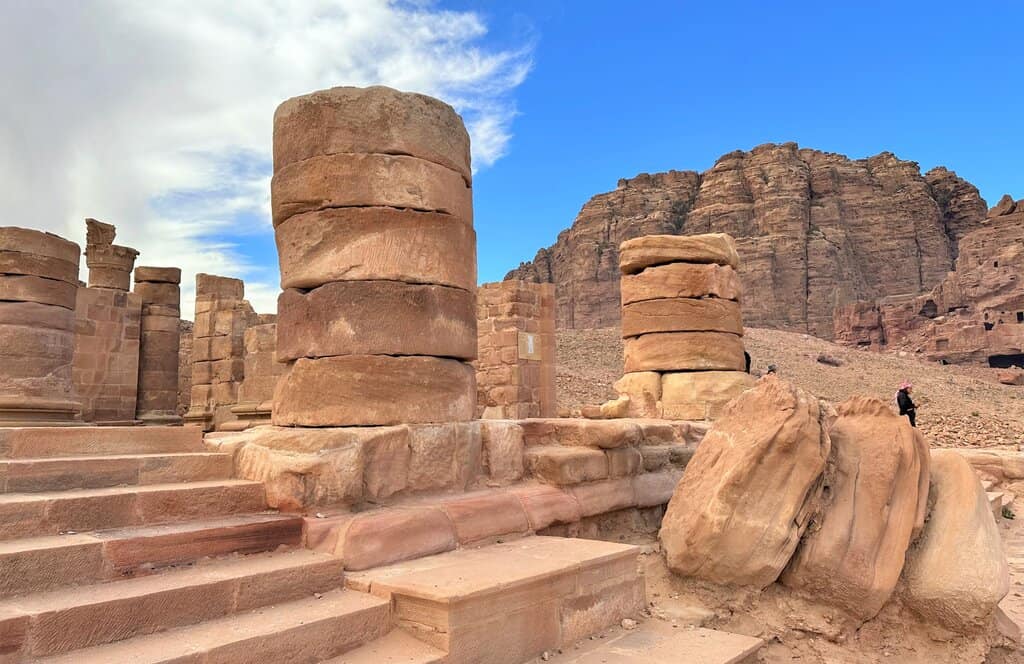
The Place of High Sacrifice
The high place of sacrifice is – as you guessed – a place where they used to make sacrifices to the gods. These were mainly in the form of goats and other animals. As far as anyone knows humans were not sacrificed here.
The site is located at the top of the mountain just behind the Treasury. It’s about 800 steps up in less than a mile, but once you get there you get a fantastic view of the heart of Petra, including the Royal Tombs, The Great Temple, and the various churches.
The High Place of Sacrifice itself is nothing more than a large obelisk and some troughs carved into the top of the mountain. The main draw for doing this hike is the view.

The Monastery
While there are tons of individual sites within Petra, we can’t cover them all here. So we will save the best for last. The Monastery is the most magnificent structure in all of Petra.
Of all the rock-carved buildings in the ancient city, it’s the largest and the most isolated. It sits high above the rest of Petra, accessible by 800 steps up a crevice in the mountain. Or if you’re entering Petra the back way, it’s the very first thing you see.
Constructed sometime during the first century AD, the Monastery measures 48 meters wide by 47 meters tall. You can’t go inside anymore, as it’s protected, but there is ample room to enjoy it from the outside. Read on for how to get the absolute best views of the Monastery on your day in Petra!
Souvenirs and Solicitations
One final thing to mention about the setup and layout of Petra is that souvenir stands are everywhere. Literally everywhere. There are far too many and they all sell the same things.
While I wish the authorities would put a cap on how many Bedouins could operate souvenir stands, I understand that it’s really the only way they make money. Just don’t be surprised when you’re bombarded constantly to buy things.

And speaking of being bombarded by people looking for your money, you can reasonably expect to be hounded by the locals to buy something or purchase some service all day in Petra. It kinda sucks but it’s the way it is. It’s not nearly as bad as Cairo, and I wouldn’t call it overwhelming, but it can get frustrating after a while.
Camel rides, horse rides, secret hikes, souvenirs, food, the list goes on and on. Just remember that you don’t actually have to buy anything or purchase any service. Just try to ignore it and you will love your day in Petra!
The Back Entrance of Petra
The back entrance to Petra is located as shown on the map below. It’s basically just a checkpoint on the hiking trail between Little Petra and the Monastery. Little Petra is exactly what it sounds like, a tiny version of Petra, with a few small buildings carved into the rocks. It’s about 15 minutes from Petra’s main entrance by road.
While Little Petra is free to enter, you will need your Petra ticket to enter Petra from the back entrance. Not your Jordan Pass. The actual Petra ticket. This means you must go to the ticket office and have your Jordan Pass scanned before making your way to Little Petra or the day before if you have a multi-day pass. We went with the three day pass and got our tickets the afternoon before. Highly recommended.
Why start at the back entrance of Petra?
The obvious answer to this question is that starting at the end seriously reduces the number of people you will see at the Monastery. As it’s at the very end of Petra, people entering from the main entrance have a 3.5 mile hike to the Monastery. If you enter first thing in the morning from the back you’ll have less people and possibly even solitude when you get there.
We arrived at the Monastery at about 7:45 AM and I kid you not we had the place to ourselves for literally 45 minutes before we heard other human voices. It was just us and a family of adorable dogs who followed us everywhere. The photos below are not photoshopped at all. There was just no one else there!
The other reason to start at the back entrance to Petra is that you can avoid the 800 steps up the final mile of the trail to the Monastery from the main entrance.
If you’re like me and love climbing mountains these steps are no big deal, but for most people the thought of avoiding an intense upward climb is very appealing. You’ll still have plenty of climbing for the day, but you’ll skip the toughest part.
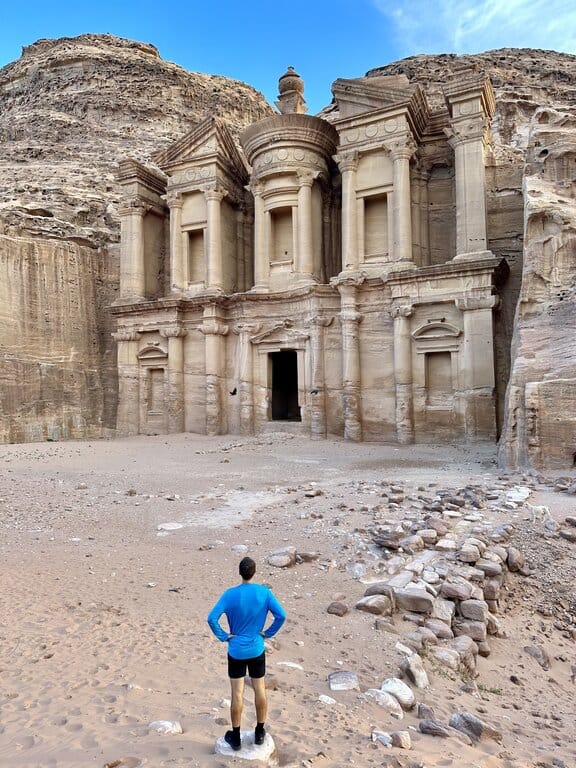
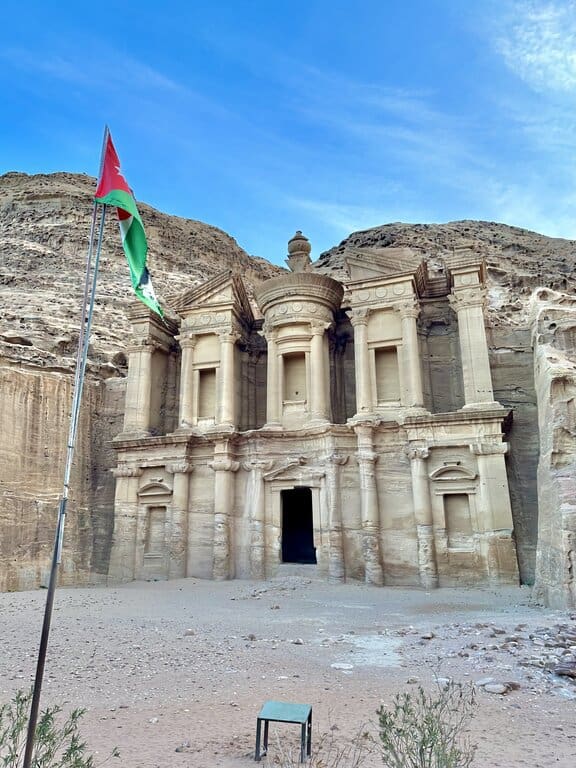
How to get to the back entrance of Petra
There are a few different ways to get to the back entrance of Petra, the spot noted as “Back Door hiking route to the Monastery” on the Google Map above).
Option 1: take the shuttle to Little Petra
This is the most popular option. A free shuttle runs between Petra’s main entrance and little Petra every day from about 7:00-16:00. The actual time the first shuttle leaves is dependent on the season and how busy it is.
The shuttle won’t leave without being full. This means that in winter you might have to wait a bit longer. As Petra opens at 6 AM (6:30 Nov – Mar), you have time to get your entry ticket before the first shuttle leaves or the day before.
The ride takes about 15 minutes. Once you’re at little Petra you have two options for getting to the back entrance. You can walk or you can take a government run 4×4 taxi.
The hike from Little Petra to the Monastery is 4.2 miles through rugged sandstone mountains on a trail that few have described as well-maintained. It’s certainly a gorgeous hike, though you should not attempt it in the dark unless you’re a seasoned headlamp hiker.
The 4×4 option costs 5 JOD per person (cash only). They’ll herd you into the back of a pickup truck and off-road you to the checkpoint. It’s about a 15-20 minute bumpy ride and from there you’ll hike the remaining part, about 1.3 miles with significant ups and downs but a decent trail.
With Option 1 the earliest you can reasonably get to the Monastery is about 8:00-8:30 AM (if you do the off road taxi option). You’ll be one of the first people there, as the earliest main entrance hikers start to arrive around 9. Though a really fit hiker could presumably walk from the main entrance to the Monastery in under two hours.
Option 2: get a taxi to Little Petra
If you don’t want to wait for the shuttle you can take a taxi from Wadi Musa to Little Petra. You should be able to negotiate this for 10 JOD. It’s only a 15 minute drive on a paved road.
From there your options are the same as above. But a key thing to note here is that the 4×4 taxis might not leave until the first shuttle arrives, especially if they are not full. If you have a large group and a driver is available they will take you earlier. But if it’s just 2 or 3 of you, you’ll be stuck waiting for more people before they’ll drive you to the checkpoint.
If you plan on hiking you can get a taxi as early as you want. Just be careful if you’re in the dark, as the trail can be treacherous in some parts. Sunrise is really early in spring and summer, but if you’re there in fall or winter the sunrise might be as late as 7:30
Option 3: drive yourself to Little Petra
You can always drive yourself and park at Little Petra for free. Again your options from there are the same. And you’ll also have to arrange transportation back to Little Petra if you miss the last shuttle. I advise against this option.
Option 4: get a ride directly to the back entrance checkpoint
That brings us to the fourth and final option: scoring a ride directly to the checkpoint. This is the “secret” option that is technically not supposed to be allowed. But if you ask around enough, you’ll find a local who will take you off-road from Wadi Musa directly to the back entrance checkpoint, which leaves you with the 1.3 mile hike to the Monastery.
This is by far the fastest – yet most expensive – way to get to the back entrance of Petra. We paid 30 JOD to our driver and that was after haggling. We were picked up at our hotel at 6:30 AM and driven in the dark (it was November) to a dusty spot on an old 4×4 road where we were dropped off and pointed in the right direction. It was right off the hiking trail and the trail was easy to follow from there. It was so early that nobody was even working at the checkpoint yet!
The hardest part about this option is scoring the ride. Normal taxi drivers won’t do it (though they might know someone who will). Best to inquire at your hotel. If you ask around enough you’ll find someone who offers this service.
The locals have to be quite hush hush about it since they’re really not supposed to be doing it. That’s why they charge so much. But it was totally worth it for 45 minutes of solitude at one of the most famous places on the planet.
The hike to the Monastery
No matter how you get to the checkpoint, you will have to hike at least 30-60 minutes (1.3 miles, so it depends on your pace) to the Monastery. This part of the hike is not difficult and the trail is well defined, mainly by ancient stone steps. There are a few vendors selling tea and souvenirs and after a little over a mile you reach the second most famous building in Petra.

There’s no way to describe the feeling when you first lay eyes on Petra. A giant façade carved directly into the side of a mountain, red and tan rocks everywhere. The Monastery is actually larger than the Treasury and for many people more impressive. There is a tea shop that sells food and drinks but other than that you can sense what it was like to be here 2000 years ago.
The best spots for photo ops at the Monastery
There are quite a few vantage points that offer awesome views of the Monastery. The little tea house itself has a great view. But for the best views you’ll have to climb up a little.
Spot 1: just above the tea house
There is a large rock right behind the tea house that is easy to scramble up. There is no one on top of the rock trying to sell you things. Looking at the tea house with the Monastery directly behind you the rock is to your left. You can’t miss it. The photo below is from this viewpoint.
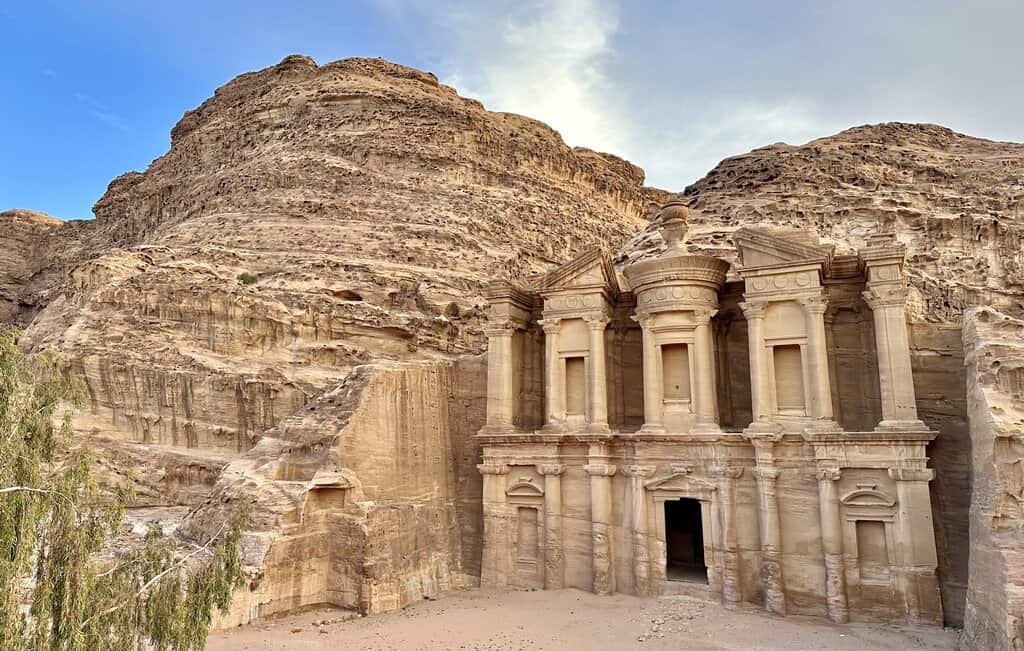
Spot 2: in the cave
Looking at the tea house again with the Monastery behind you, if you look to the right of the tea house you’ll see an isolated rock with a little cave in it. Go inside the cave and look out to get the view seen in the photo below.
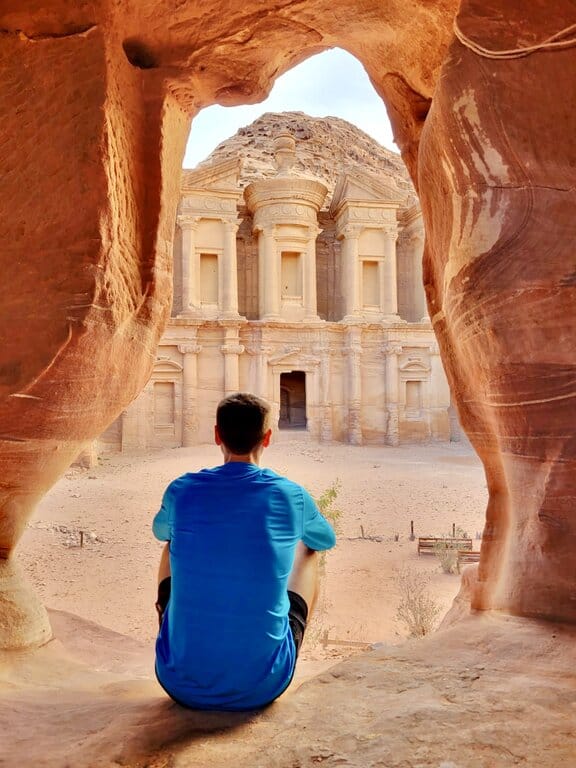

Spot 3: high above the Monastery
From the tea house you will see signs for “best view Petra” or “Petra best view”. Follow those signs and you’ll see two trails high up the rocks, one to the left and one to the right. Each has a small tea house atop the rock and you’ll have to buy something to get through. That is, unless you get there early like we did. No one was working up there at 8 AM.
The hike to the top is pretty steep but takes no more than five minutes. From the viewpoint on the left you get the beautiful view seen in the photo below. The viewpoint on the right gets a view from more straight on. As we didn’t go up that one I have no photo to show you. If you have time you can certainly do both.
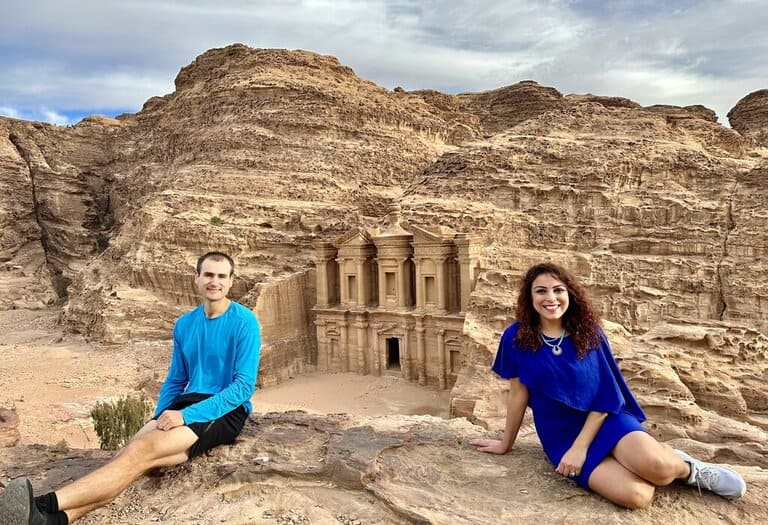
Into Petra you go
When you’re satisfied with the Monastery, it’s time to start the 3.5 mile walk back to the entrance, stopping at all the awesome other sites discussed above on the way.
You’ll first pass through some shops, maybe see some groups of puppies or kittens, then begin the descent to the rest of Petra. As mentioned before, it’s 800 steps up to the Monastery, so you’ll be going down 800 steps. As you walk, try to imagine how these stairs were carved into the rock 2000 years ago.
The first little site you’ll get to is the Lion Triclinium, which will be on your right. It’s basically some giant keyholes into the cliff. It’s nothing spectacular but worth a quick stop. Heading down more steps you’ll finally reach the valley, which is a dry river bed with palm trees and other green vegetation, a rare sight in Petra. There are even two poorly reviewed restaurants if you’re starving. And if you look up you’ll see some cave homes where some Bedouins still live.
Next you’ll be greeted by the ruins of some structures that were built in the valley. That’s right, not everything in Petra is carved into the mountain. They used sandstone masonry to build the Great Temple, the Byzantine Church, and Qasr al-Bint to name a few. There’s even a cobblestone street that used to be the main downtown market for Petra.
The street ends at the Royal Tombs. From there you can go to the left past the tombs to do the hike to the Treasury viewpoint. Or you can go right and pass some more tombs, the amphitheater, and eventually the Treasury on your way back to the main entrance.
Petra At Night
If you’re staying in Wadi Musa on a Monday, Tuesday, or Thursday night, you will have the opportunity to experience Petra at Night. On these nights, the park sells separate tickets at 17 JOD per person for the Petra at Night show. You must purchase these tickets at the main ticket office but at a special stand. It’s well marked and you can’t miss it.
Petra at Night is not included in your main Petra ticket and it cannot be reserved in advance. They don’t sell out though, so you can get it any time during the day until they close at 4:30 PM. Bring cash, as for some reason credit is not accepted for Petra at Night tickets.
You also must have a valid ticket for the day of in order to get the Petra at Night ticket (i.e. you can’t have a ticket for the next day only or the previous day). The gates to the park open at 8:30 PM.
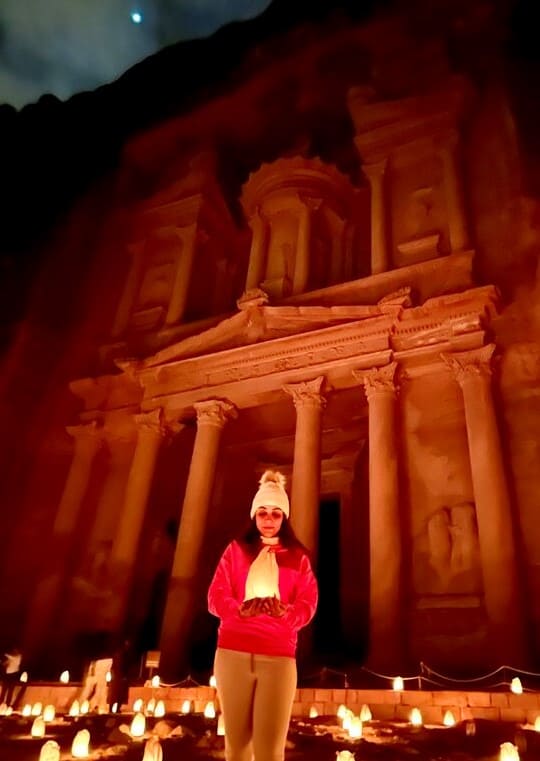

What is Petra At Night?
So what exactly is Petra at Night? Well, it’s sort of hard to describe. At a macro level, it’s an opportunity to see the Treasury lit up at night by hundreds of candles. The walk from the main entrance to the Treasury is lined with candles so it’s safe to walk. While it’s not totally dark, a flashlight is still suggested for the walk through the Siq.
When you get to the Treasury, you’ll see the ground in front of the building lined with candles and mats. The Bedouins will instruct you where you can sit, as you can’t sit in the very front row. Before sitting, you’ll have some time to snap a few night photos like the ones below.
The performance
So what are you sitting for? Well, Petra by Night is actually a show, if you want to call it that. The show starts at 9 PM and runs barely 30 minutes. It’s essentially some local Bedouins playing traditional instruments.
One plays the flute and the other a single stringed instrument known as a rababa. The rababa player also sings – sort of. As much as I respect the Bedouin culture, I can’t tell you that the performance was anything to be remembered….
There is also an MC who speaks adequate English and goes over a little history of Petra between performances. He is super happy that Petra was named one of the New Seven Wonders of the World. He will mention that at least three times. During the show, different color lights will shine on the Treasury. That is definitely the best part, as you get to see it all purple and green and red.
Conclusion
It’s definitely worth going to Petra at Night if you are in town on the right day. We absolutely love our night photos at the Treasury. Just don’t expect an amazing artistic performance and you won’t be disappointed!
Frequently Asked Questions
How do you get to the backdoor of Petra?
You can get to the backdoor of Petra by a combination of vehicle and hiking. It’s best to read the detailed information above in this article before attempting to visit Petra by the back entrance.
Do you have to be fit to visit Petra?
No, you do not have to be fit to visit Petra. But you might be pretty miserable when you visit the Monastery if you’re very unhealthy. Visiting the Treasury is easy for anyone and even has handicap access. The Monastery requires some serious uphill hiking. Being fit is always nice for a day in Petra.
How many entrances are there to Petra?
There are two entrances to Petra: the main entrance and the back entrance. Almost everyone enters from the main entrance. But you want to go through the back entrance. This article is dedicated to helping you find your way to the back entrance of Petra before everyone else!
Can you go inside the Petra Treasury?
No, you cannot go inside the Treasury at Petra. You used to be able to but since humans are not responsible nobody can anymore. Same with the Monastery.
Petra Back Entrance – Final Word
Petra is one of the most spectacular ancient cities in the world. If you hike in the back way like we’ve discussed in this post, you will likely have the world famous Monastery all to yourself for a significant amount of time. And no words can describe how special that experience is. I’m sure you’ll love Petra even more since you went in from the back entrance!

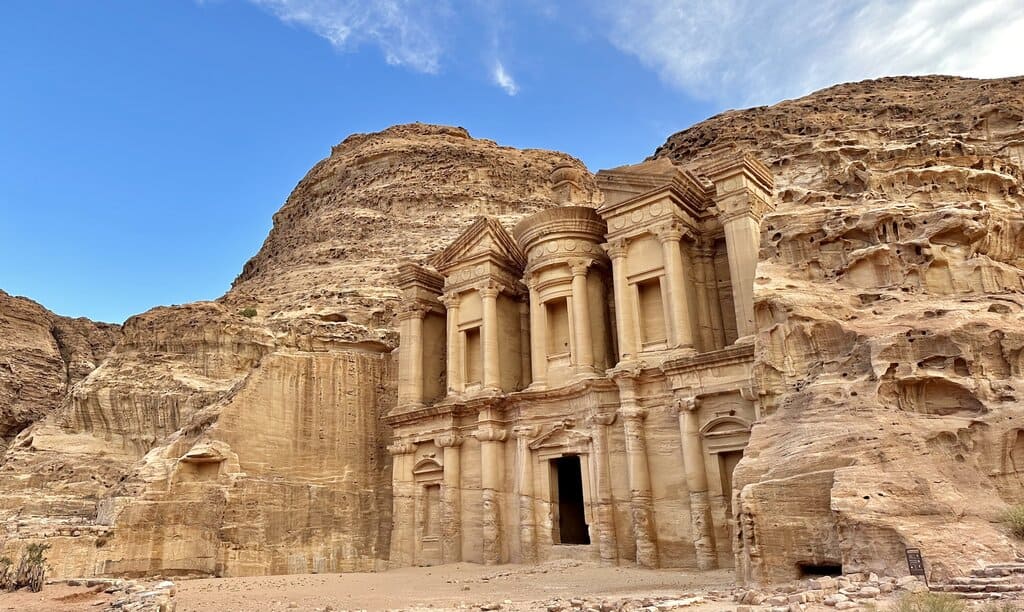
8 comments
Does the 5 JD include return trip? Or each way?
Hi, I assume you mean the 4×4 drive from Little Petra. That 5 JOD is one way, but you only take it one way, as once you get to the back entrance of Petra you walk through the site in reverse back to the main entrance which is right in the town.
Hello, thanks for all the tops,
Could you send me by mail the contact of the driver for the back entrance?
Hi Elise,
I didn’t have direct contact with my driver, as my hotel set it up for me and he was just there at 6:30 AM for me. Talk to your hotel about this option, as they likely know someone. If not, I stayed at Esperenza Petra and you can either stay there or get in touch with them through Booking.com or direct email and see if they can hook you up with a ride. They were really friendly so I’m sure they’ll help!
[…] high above the rest of Petra, accessible by 800 steps up a crevice in the mountain. If you access Petra from the back entrance, it reduces the number of people you will see at the Monastery. There are other attractions like […]
[…] If you want to see the Monastery early in the day, without all the crowds, enter Petra from the back entrance. […]
[…] If you’re looking for an epic 40th birthday trip idea, look no further than a trip to Jordan. Here, you can swim in the Dead Sea, sandboard in the Wadi Rum Desert, and discover the ancient city of Petra. […]
[…] in many traveller reviews (via Trip Advisor, YouTube, websites etc.) we stumbled across a brilliant traveller’s website which filled in the gaps. Phew! Thanks Chris! (Btw… He also has lots of other […]